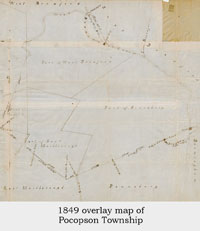
Founding of Pocopson Township
 The founding of Pocopson Township story starts with a petition to the Court of Quarter Sessions in late 1848, signed by 28 male inhabitants of Pennsbury, West Bradford, East Marlborough and Newlin Townships, pleading that “they labor under great inconvenience for want of a new township to be composed of part of (their existing) townships.” Of the 28 signers, some families were heavily represented: the Sellers (Samuel, Samuel W., Isaac, Israel and Johnathan) ; the Barnards (William, Eusebius and Vincent); the Martins (George, Thomas, Simon and Samuel); and the Woods (John and William T.)
The founding of Pocopson Township story starts with a petition to the Court of Quarter Sessions in late 1848, signed by 28 male inhabitants of Pennsbury, West Bradford, East Marlborough and Newlin Townships, pleading that “they labor under great inconvenience for want of a new township to be composed of part of (their existing) townships.” Of the 28 signers, some families were heavily represented: the Sellers (Samuel, Samuel W., Isaac, Israel and Johnathan) ; the Barnards (William, Eusebius and Vincent); the Martins (George, Thomas, Simon and Samuel); and the Woods (John and William T.)
 The “great inconvenience” is nowhere spelled out in the archives, but the court appointed three men “to inquire into the propriety of granting the prayers of the petitioners.” In late January, 1849, the three men reported back to the court that they were “fully satisfied that there is ample reason to justify the conclusion that there is occasion for such a new township.” Their report did not go on to specify exactly what went into this “ample reason.”
The “great inconvenience” is nowhere spelled out in the archives, but the court appointed three men “to inquire into the propriety of granting the prayers of the petitioners.” In late January, 1849, the three men reported back to the court that they were “fully satisfied that there is ample reason to justify the conclusion that there is occasion for such a new township.” Their report did not go on to specify exactly what went into this “ample reason.”
 Three of the townships which would lose territory vigorously contested this conclusion. On May 1, 1849, separate “remonstrances” were filed by 74 men from Pennsbury, 108 from East Marlborough, and 14 from West Bradford…all arguing against the Court’s confirming the new township. They argued that they had not been sufficiently informed of what the commissioners were doing and that these townships were not presently so large as to be inconvenient to their citizens. In addition, Pennsbury noted that it had recently rearranged its school districts and had constructed a new school (Darlington School) which would become part of the new township.
Three of the townships which would lose territory vigorously contested this conclusion. On May 1, 1849, separate “remonstrances” were filed by 74 men from Pennsbury, 108 from East Marlborough, and 14 from West Bradford…all arguing against the Court’s confirming the new township. They argued that they had not been sufficiently informed of what the commissioners were doing and that these townships were not presently so large as to be inconvenient to their citizens. In addition, Pennsbury noted that it had recently rearranged its school districts and had constructed a new school (Darlington School) which would become part of the new township.
Nevertheless, the new township was approved by the Court, and a September 13, 1849, filing ordered an election of township officers for Pocopson. The township was named after Pocopson Creek, which flows through the southern part of the township, and cited on maps as early as 1711. “Pocopson” comes from pocaupsing, an Indian word meaning “roaring waters.” Not that “Pocopson” was the unanimous choice. The names “Union” and “Locust Grove” were also proposed. But, as Futhey and Cope proclaim in their classic History of Chester County, “the inhabitants had the good sense to select that given it.”
Pocopson is among the few townships with Indian names, because the early settlers rather preferred to name their townships after their homelands. For instance, both Marlborough and Bradford were named after towns in England. Pennsbury was named for William Penn’s plantation, Pennsbury Manor, on the Delaware River in Bucks County. Newlin, on the other hand, was named for Nathaniel Newlin, who originally purchased the land.
If it is still not clear why Pocopson Township was formed, it was not unusual to form new townships out of existing ones. Locally, for instance, Marlborough was founded in 1700, and divided into East and West Marlborough in 1729. Bradford was founded in 1705, and divided into East and West Bradford in 1731. Newlin dates back to 1724, and Pennsbury to 1770.